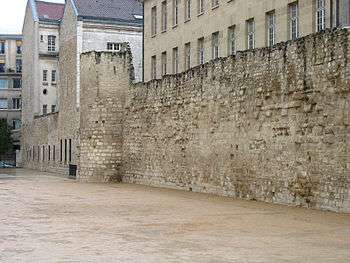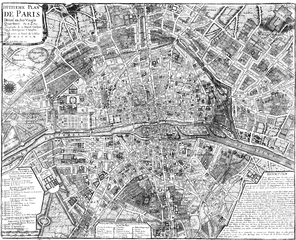City walls of Paris

Walls of Paris (enceintes de Paris or murs de Paris in french), refers to the city walls that surrounded Paris as it grew from ancient times until the 20th century, built primarily to defend the city. Several successive city walls were built, with the exception of 1670, when Louis XIV ordered the demolition of the Louis XIII Wall, through 1785, when construction began on the Wall of the Farmers-General. The city walls of Paris include:
- a Gaulish enclosure (location unknown).
- a Gallo-Roman wall.
- two medieval walls, one of which was the Wall of Philippe Auguste.
- the Wall of Charles V, extending on the right bank.
- the Louis XIII Wall, extending on the western part of the right bank.
- the Wall of the Farmers-General, for tax purposes.
- the Thiers wall.
As Paris expanded over time, new walls were built to consolidate the existing city with new houses, gardens, and vegetable fields. Existing walls would eventually be destroyed and its site built up into a street or boulevard. Only a few sections of the Wall of the Farmers-General (pavilions of Claude Nicolas Ledoux) and the Wall of Philippe Auguste survived. The walls' influence on modern Paris can still be seen on some of its major streets and boulevards such as:
- The 'Grands boulevards' (main streets), built by replacing the Charles V and Louis XIII Walls.
- The parallel streets Rue de Cléry and Rue d'Aboukir (2nd Arrondissement) tracing the route of the Charles V Wall.
- The outer boulevards, built in place of the Wall of the Farmers-General.
- The 'boulevards des Maréchaux' (Boulevards of the Marshals, a loop encircling the city consisting of boulevards named for the Marshals of France), built to replace the Thiers Wall.
- The Boulevard périphérique (ring road or beltway), built outside the boulevards des Maréchaux.
Gaulish enclosure
Before its occupation by the Romans Lutèce lacked defenses as such and it was partially demolished at the beginning of the Roman occupation, The first wall of Paris was probably built by the Gauls on the river Seine, although its exact location is unknown. In his Commentaries on the Gallic War, Julius Caesar wrote: "Id est oppidum Parisiorum, quod positum est in insula fluminis Sequanae", indicating that Lutetia (former name of Paris, the town of the tribe of Parisii) was a fortified camp on an island. The relationship between this island and the Île de la Cité has not been demonstrated, and excavations have not uncovered anything earlier than Augustus. This is also unclear due to the discovery in 2003 of the remains of a city on a site now occupied by Nanterre.
Gallo-Roman wall
Lutetia developed on the left bank of the Seine during Roman times, and to a lesser extent on the Île de la Cité. The right bank was uninhabitable mostly due to marshes. During the first barbarian invasions in 285, the people of Lutetia abandoned the left bank and took refuge on the Île de la Cité and destroyed the bridges. The eastern half of the island was protected by a wall, constructed of rocks collected from the Arènes de Lutèce.
First medieval wall
Traces of an enclosure at the corner of the rue de l'Arbre-Sec and the rue de Rivoli were discovered in 2009 during excavations made by Institut national de recherches archéologiques préventives (INRAP), the French National Institute for Preventive Archaeological Research. This confirmed the probable existence of an enclosure around the centre of Paris on the right bank around the tenth century. This is most likely the result of a Viking siege in 885 and constructed by either Odo of France, or Robert I of France. The fortification had a 12 by 3 meter wide ditch and was likely to have been supported by a wooden fence.
Wall of Philippe Auguste

The Wall of Philippe Auguste was built between 1190 and 1213, enclosing 253 hectares on both sides of the river Seine. Many elements were later incorporated into private buildings or into the Wall of Charles V.
Paris grew very fast at this period and soon extended on the one hand to the Montagne Sainte-Geneviève and on the other to the roads leading to the abbey of Saint-Denis. A new wall was thus begun in 1190, on the order of Philip Augustus but paid for by the city. This new wall was eight feet thick, protected by wide and deep ditches, and had five hundred towers.
It ran from the current location of the Pont des Arts, approached the porte Saint-Honoré, opened at the porte Coquillière, reached the porte Saint-Denis, porte Mauconseil, porte Babette, came to rue Vielle-du_Temple, the rue des Francs-Bourgeois, to the porte Baudoyer and the quai des Célestins. On the south side this wall picked up at the Palais de la Tournelle, opened at the porte Saint-Victor, porte Bordet, porte Saint-Jacques, Porte Saint-Michel, porte des Corderliers, near the cour de la Commerce, the porte de Buci, and ended at the Tour de Nesle, the Nesle tower.
Wall of Charles V
The Wall of Charles V was built from 1356 to 1383, during the reign of Charles V and his son and successor Charles VI. The area enclosed on the right bank increased and included the mansions of the Marais and the Templar enclosure. The area enclosed on the left bank remained the same as did the Wall of Philippe Auguste. The new city limits totaled 439 hectares across the two banks. During the construction of the Wall of Louis XIII, this wall was partly incorporated into the new wall and partly destroyed.
Louis XIII Wall (also known as the "yellow ditches wall")

The Louis XIII Wall was designed by Jacques Lemercier and built between 1633 and 1636. It enlarged the Charles V Wall over the western part of the right bank (now the First and Second Arrondissements).
From 1670 onwards, Louis XIV believed that as a result of his conquests, Paris had been made a secure city. He ordered the wall destroyed and replaced it with the future grands boulevards.
Wall of the Farmers-General
The Wall of the Farmers-General was built in the years after 1785 under the direction of Claude Nicolas Ledoux and at the request of the Ferme Générale. It enclosed 3402 hectares, including the village of Austerlitz which was incorporated into Paris in 1818.
This wall was later replaced by the second belt of boulevards: Charonne, Ménilmontant, Belleville, La Villette, La Chapelle, Clichy, Batignolles, Courcelles, avenue de Wagram and Iena, streets Benjamin Franklin and Alboni, boulevard de Grenelle, Garibaldi, Pasteur, Montparnasse, Edgar Quinet, Raspail, Saint-Jacques, Auguste Blanqui, Vincent Auriol, Bercy and Picpus. Unlike previous walls, the goal of this wall was not to defend Paris, but to force the payment of taxes on goods entering the capital. It was destroyed when Paris was extended up to the Thiers Walls in 1860.
Thiers Wall
The Thiers Wall was constructed from 1841 to 1844 after a law enacted by Adolphe Thiers. It covered 7802 hectares, along the boulevards des Maréchaux of today and a glacis extending to the location of today's Boulevard Périphérique. It was demolished between 1919 and 1929.
 The poterne des Peupliers, the only remaining trace of the Thiers wall
The poterne des Peupliers, the only remaining trace of the Thiers wall- The porte de Pantin about 1908
- The fortifs zone, in Saint-Ouen
Sources
- This page is a translation of its French equivalent.
Bibliography
- Renaud Gagneux et Denis Prouvost, Sur les traces des enceintes de Paris, Parigramme, 2004.
- Jacques Hillairet, Dictionnaire historique des rues de Paris.
- Guy le Hallé, Histoire des fortifications de Paris et leur extension en Île-de-France, Éditions Horvath, 1995.
- Guy le Hallé, in « Paris aux cent villages », mensuel (mai 1975–janvier 1982) :
See also
External links
| Wikimedia Commons has media related to City walls of Paris. |
- (French) Paris walls (with a map)
- (French) Guy Le Hallé, The history of "fortifications" (Thiers wall) à Saint-Ouen
- (French) Malakoff Infos, idem in Malakoff